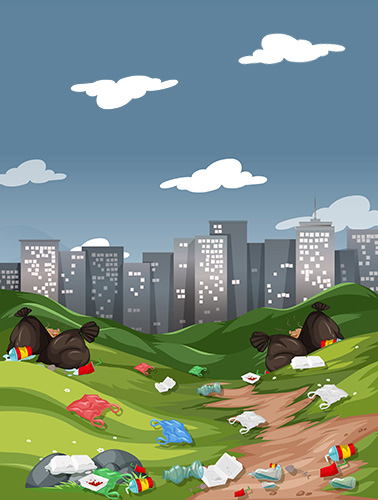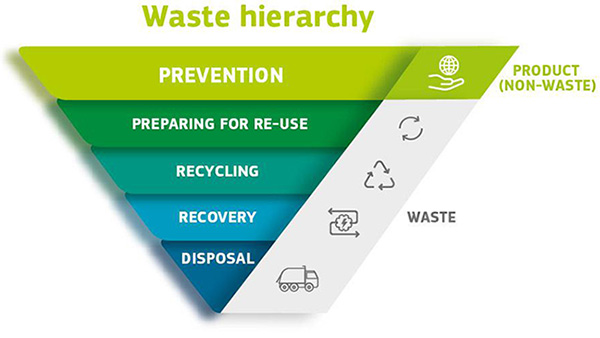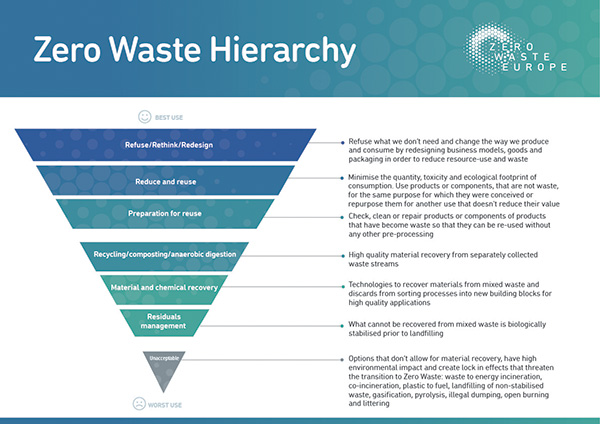
Municipal Waste
There are two primary types of waste - municipal waste (communal garbage) and industrial waste (a wide variety of waste materials generated by industries or industrial processes). Waste can be hazardous and non-hazardous as classified in the European List of Waste (LoW), Decision 2000/532/EC. Hazardous waste is waste that is dangerous or potentially harmful to human health or the environment.Municipal Waste (MW) is defined as waste collected and treated by or for municipalities.
Municipal waste covers household waste (HW) and waste similar in nature and composition to household waste. It means that MW covers waste from households (separately collected waste including paper and cardboard, glass, metals, plastics, bio- waste, wood, textiles, packaging, waste electrical and electronic equipment/WEEE, waste batteries and accumulators, and bulky waste, including furniture, and mixed waste), similar waste from commerce and trade, office buildings, institutions (schools, hospitals, government buildings, etc.) and from small businesses, as well as yard and garden waste (including leaves, grass clippings, etc.), and waste from selected municipal services (from public parks and gardens, from street cleaning services (including street sweepings, contents of litter containers), and market cleaning waste if managed as household waste). The definition of Municipal Waste excludes waste from production, agriculture, forestry, fishing, septic tanks and sewage networks and treatment (including sewage sludge), end-of-life vehicles (ELV) as well as waste from construction and demolition activities (CDW). The above definition of MW is provided in the EU Waste Framework Directive (WFD) 2008/98/EC, amended by Directive (EU) 2018/851.
Municipal Waste Management (MWM) means collection, transport, recycling (including sorting), recovery, and disposal of waste, including the supervision of such operations and the after-care of disposal sites. The foundation of EU waste management is the five-step "waste hierarchy", established by the WFD. The waste hierarchy sets an order of preference for managing and disposing of waste, as presented in Figure 1link.

Figure 1. WFD: Waste hierarchy in MWM
To increase the demand and the value of recycled materials, improving the quality of collected materials is essential. Since sorting waste at source (at locations where it is generated) is one of the key conditions to achieve better quality of recyclables, setting up schemes for separate collection is essential for each country. Separate collection means collection from locations where a waste stream is kept separately by type and nature so as to facilitate a specific treatment. Separate collection could be achieved through door-to-door collection {organized and financed by municipalities (e.g. mixed waste and bio-waste) or EPR (extended producer responsibility) organizations (e.g. packaging), bring and reception systems in dedicated street containers (overground or underground), or other collection arrangements like home composting incentives (kitchen and green waste), periodic pick-ups (e.g. mobile collection), in-shop take-back via EPR systems and at civic amenity sites (CAS). Separate collection of waste streams is critical for achieving targets of Circular Economy (CE), to eliminate waste for landfilling and minimise pollution, circulate products and materials (at their highest value), and to regenerate nature, by applying the more ambitious 5R's principles: Rethink, Refuse, Reduce, Reuse, Recycle (as opposed to the more traditional: Refuse, Reuse, Recycle, Recover, Residue WM).
According to the EU Waste Framework Directive, MW shall be subject to separate collection of at least paper, plastics, glass, metals, household hazardous waste (HHW), textile, and biowaste, and shall not be mixed with other waste or other materials with different properties. Bio-waste is biodegradable garden and park waste, food and kitchen waste from households, offices, restaurants, wholesale points, canteens, caterers and retail premises, and comparable waste from food processing plants. Compliance with the obligation to set up separate collection systems for paper, metal, plastic, and glass is essential to increase the re-use and recycling rates.
In addition, bio-waste should be collected separately to increase re-use and recycling rates and to prevent contamination of dry recyclable materials. Bio-waste is wet and difficult to remove from other recyclables, and it contaminates other types of waste. Furthermore, separate collection of bio-waste is needed to achieve a high-quality compost/digestate. Indeed, impurities such as plastics, glass and metals will be difficult to extract during bio-waste treatment and reduce the value of the compost or digestate. In order to avoid waste treatment which locks in resource at the lower levels of the Waste Hierarchy, to enable high-quality recycling and to boost the uptake of quality secondary raw materials, all countries should ensure that bio-waste is separately collected and undergoes recycling in a way that achieves high level of environmental protection and output of high-quality standards.
High-quality recycling is the reprocessing of waste into materials which have a similar or higher economic value in comparison to the products or applications from which the waste originates. Prevention of waste is, among others, to repair and reuse of products without compromising their quality and safety. 'Recovery' and the opposite term 'disposal' (negatively defined as operations which are not recovery) together comprise 'waste treatment'. Recovery is divided into three sub-categories: preparing for re-use, recycling and other recovery. Waste that has been separately collected to prepare for re-use and recycling must not be incinerated, except for waste resulting from subsequent treatment operations of the separately collected waste for which incineration delivers the best environmental outcome. This applies to all waste streams. Disposal of Municipal Waste is allowed only for this MW which cannot be recovered or for the end-waste from recovery.
When products, materials and substances become waste, the presence of hazardous substances may render that waste unsuitable for recycling. Therefore, it is necessary to promote measures to reduce the content of hazardous substances in materials and products, including recycled materials, and to ensure that sufficient information about the presence of hazardous substances and especially substances of very high risk is communicated throughout the whole life cycle of products and materials.
Reuse, unlike preparing for reuse, is a process entailing the treatment of products to prevent waste generation; it should therefore be regarded as a specific waste prevention measure and incentivized. Waste management collectors should make waste products or end-of-life spare parts available for reuse actors even when other types of waste management would be more convenient.
The EU Waste Framework Directive lays down the general waste management principles. It requires that waste be managed as follows:
End-of-waste criteria specify when certain waste ceases to be waste and becomes a product, or a secondary raw material.
Zero Waste Europe concept offers a new proposal for a waste hierarchy in line with the Circular Economy.

Figure 2. A Zero Waste hierarchy for Europe
The current waste hierarchy, as it appears in the Waste Framework Directive, is a good tool to provide guidance in the transition to modern waste management. However, it is limited. Zero Waste Europe calls for a new hierarchy to change the focus from waste management to resource management and ensure that the value of our resources is preserved for new generations. While the current waste hierarchy pivots around recycling and extracting energy from waste, the milestone of the Zero Waste hierarchy is the value and energy preservation via designing waste out of the systems. To achieve ambitious circularity and sustainability goals, the main priority of economic and environmental EU policies is to change consumption habits, rethink business models and make them waste-free by design.
Extended Producer Responsibility (EPR) systems shift the financial and operational responsibility of waste management from municipalities to the producers of goods. By providing the adequate infrastructure and necessary communication, EPR schemes contribute to better waste sorting and recycling. EPR has shown its merits for recycling of many waste streams such as packaging, electronics, batteries and vehicles. EPR is a strong policy instrument but requires substantial and maintained policy focus to monitoring. Also, once implemented, EPR will only fulfil its full potential if policy makers impose implementation with strict deadlines (e.g. 2 years of preparation time) and keep updating the recycling rates regularly (e.g. every 3 years) to keep on improving the recycling performance.
Pay-As-Your-Throw (PAYT) systems require households to pay when they dispose of (mixed) waste. This typically goes via labelled waste bags that have to be procured upfront, street containers that will only unlock after identification of the citizen by a personalized card or individualized bins that have a sticker or chip. It is critical that mixed waste is paid for (and relatively expensive) while recyclable streams can be (almost) free of charge to give a clear incentive to sort. Thanks to financial incentives, PAYT is an extremely powerful tool to enhance separate collection. To overcome initial resistance, introduction of PAYT should occur at low levels and progressively increase up to levels of 1 ERU or more per bag/bin of 60 litres. PAYT typically works via registered bags or bar-coded bins. For apartment buildings and very densely populated areas, (underground) public containers that automatically open after payment or identification via badge are used. Many householders dislike PAYT at start because it feels as if a 'free service' is taken away. This often results in ample fly-tipping in the first months after introducing a new PAYT scheme. Moreover, if not controlled, PAYT may lead to improper sorting which degrades the quality of the collected recyclables. Enforcement and communication programs should provide support in minimising the pollution of the collected recyclables. Moreover, if PAYT is introduced simultaneously with a decrease of the general waste collection fee/tax, acceptability can be substantially increased. Based on experience of EU countries, the balanced budget stresses the incentives for sorting, rather than the income revenues for the municipality. Consequently, PAYT can be successfully implemented if it is driven by strong political leadership and if it is accompanied by a reduction of the general waste collection fee/tax, legal enforcement and proper communication.
In Deposit-Refund Systems, the consumer pays a deposit when buying products (such as a drink in a bottle) and receives a refund when he returns the empty package (such as a bottle). Typical deposits would range around 0,2 EUR per bottle, depending on the size, material and national context. The deposit-refund system applies typically for beverage packaging but also exists for returnable products such as propane tanks. Owing to the financial incentive, deposit-refund induces an almost immediate increase of recycling rates to levels above 90%. Simultaneously, litter occurs less and some people even collect packaging to obtain refund. The benefits are partially cancelled owing to the cost of implementation and the narrow focus on specific packaging (e.g. beverage bottles). Consequently, deposit-refund is a recommended instrument, however, if equivalent results can be achieved with alternative solutions, it is not necessary.
Civic Amenity Sites (CAS) offer households a solution where inhabitants can drop off almost all sorted waste streams while the staff present on the collection site can control the quality of the incoming streams. CAS is normally focused on household waste, but a well-equipped CAS may attract waste from companies and professionals as well. To prevent acceptance of large volumes of waste by CAS, possible measures are identification by an ID-card or prohibition of large volumes.
To prevent waste generation and ensure proper waste management, continuous education and awareness on waste, 5Rs, collection/separation at source and recycling, etc., have to be ensured by all public authorities, including municipalities.
Types of hazardous waste:
- Waste electrical and electronic equipment (70-80%)- Household medical waste (5-6%)
- Construction and demolition waste (5%)
- Paints, varnishes, ink and adhesives (4-5%)
- Waste containing mercury and chlorofluorocarbons - fluorescent tubes and other mercury-containing waste
- Batteries and accumulators (3%)
- Packaging waste containing hazardous substances
- Waste from self-repair and maintenance of vehicles/machinery, household wastes, pesticides, photochemicals, asbestos (<1%)